Yes, that question: “which are better, Old World or New World wines?” Traditionalists may argue that the latter lack the prestige and quality of their Old World counterparts. Those with a preference for the New World might see these wines as better value for money, free of the price tag accompanying wines from famously exclusive Old World vineyards.
Wine Lister has compared the top 50 wines by Quality score from Old World and New. The average Quality score of the top 50 wines is 983 in the Old World and 948 in the New. Though both Worlds sit comfortably in the “strongest” section of the Wine Lister 1000-point scale for Quality, the price gap tells a different story. The average price for a top 50 ranking Old World wine is £2,114 per bottle – seven times higher than the average New World equivalent (£297).
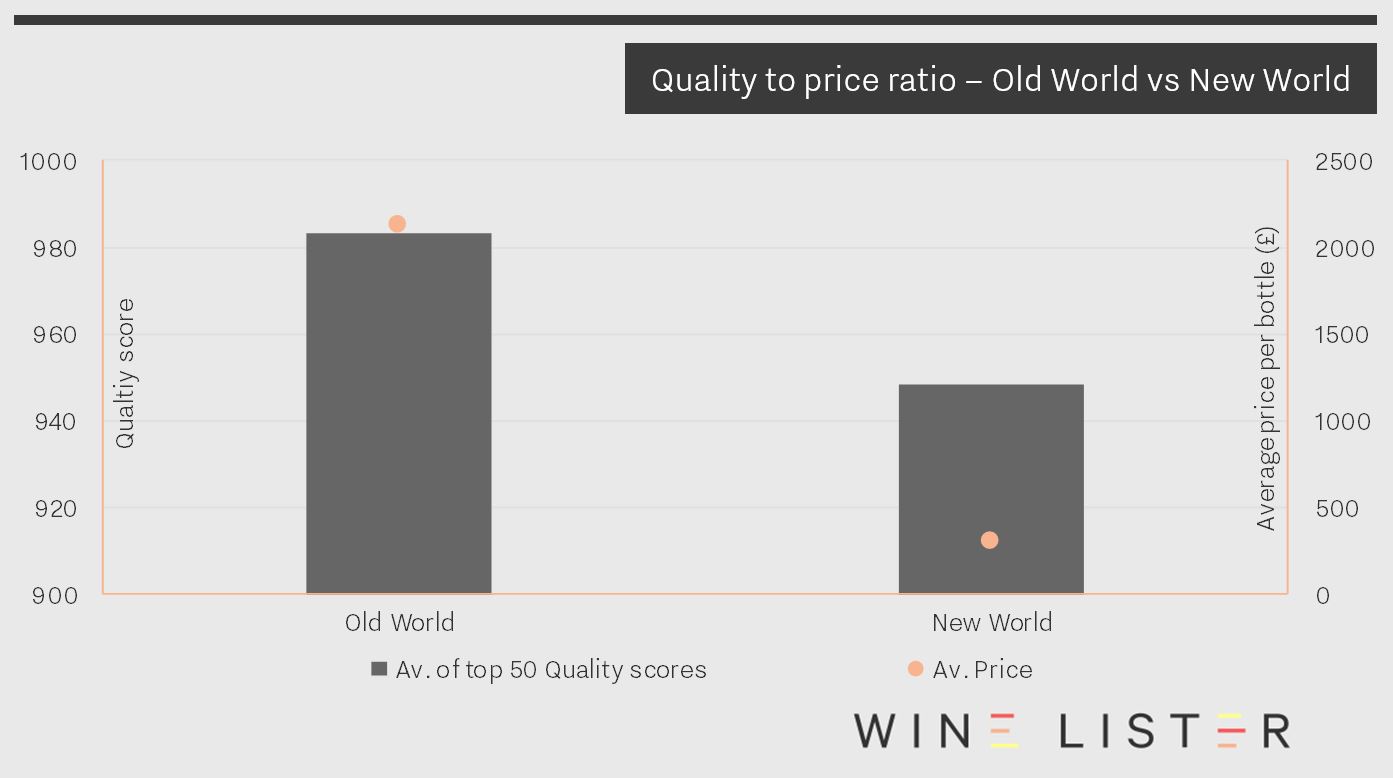
The wine with the highest Quality score on Wine Lister is Egon Müller’s Scharzhofberger Riesling TBA, which achieves a wine level Quality score of 995, having fallen just one point shy of the perfect 1,000 point score for the 2010 vintage. Riesling’s quality proliferates in the top 50, with 16 entries across Germany and Alsace. The high critics’ scores are balanced by exceptionally high prices, with an average price of £2,509 per bottle.
Though the Old World Quality top 50 is in fact white wine dominant, red Burgundy is well represented, with 13 entries and an average Quality score of 983 at £3,164 per bottle. Even excluding DRC La Romanée-Conti’s remarkable price (£11,722 per bottle), Burgundy’s remaining 12 finest reds command an average price of £2,450 per bottle.
Champagne wins the price vs quality race for the whites, with an average Quality score across its four entries of 981 at £348 per bottle. Even more impressive are the five Port entries, with an average Quality score of 982 at £244 per bottle.
In contrast to the diverse set of regions represented in the Old World top 50, the New World list is dominated by California (with 40 out of 50 wines hailing from the region). These wines achieve an average Quality score of 948 at £315 per bottle – not quite as good value as the Champagnes and Ports, but seemingly better value than their red Burgundian counterparts.
Though there are fewer entries from Australia (seven in total), the New World’s number one wine for quality comes from the Barossa Valley. Torbreck The Laird has a Quality score of 984 points and a price of £427 per bottle. When comparing this to an Old World wine of the same score, the price difference is evident. Domaine Leroy’s Romanée Saint Vivant benefits from the same Quality score, but is nearly five times more expensive, at £1,975 per bottle.
Unintentionally coinciding with today’s International Women’s Day – really, it was a complete accident – this week our Listed section looks at “pink Champagne”, namely the five most expensive rosé Champagnes. We are a bit embarrassed that it looks like we are jumping on the bandwagon and touting the colour pink today. However, as these five contenders show, top rosé Champagne represents a serious vinous offering worthy of any day or occasion.
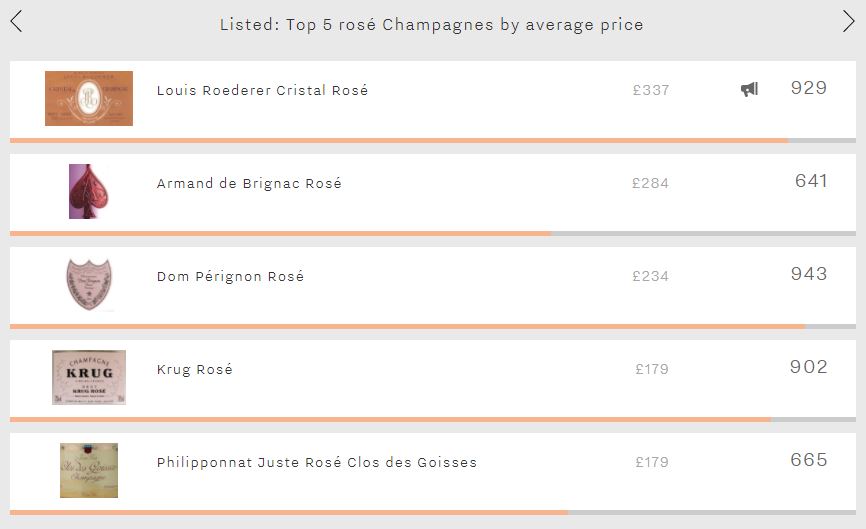
The world’s most expensive pink Champagne is Louis Roederer’s Cristal Rosé (£337 per bottle). It also achieves the highest Quality score of all rosé Champagnes (972). Whilst it receives excellent scores from each of Wine Lister’s partner critics, it is the outstanding average rating of 97/100 from Antonio Galloni’s Vinous that stands out. Cristal Rosé also pips its white counterpart to the post in the Quality category (972 vs 970), and is over twice as expensive (£337 vs £165 per bottle). However, despite its superior quality, Cristal Rosé trails its white counterpart in the Brand category by 56 points – it features on under half as many of the world’s top wine lists and is searched for 82% less frequently.
The second-most expensive rosé, Armand de Brignac’s offering, is a newcomer to the fine wine world, born in 2006. It experiences the group’s lowest Quality and Economics scores, and second-weakest Brand score. Its high price (£284) can therefore be attributed to its association with Jay-Z. The American rapper featured Armand de Brignac’s white Champagne in the video for “Show Me What You Got” in 2006 – before it even had a US importer – and eventually bought a significant portion of the house in 2014, further aligning the brand with his high-flying lifestyle.
In third place is Dom Pérignon’s rosé (£234). Whilst unable to match the peerless brand recognition of its white counterpart, it does enjoy the best Brand score of any pink Champagne (984). This is thanks to receiving on average 2.5 times as many online searches each month as the second-most popular wine of the five (Cristal Rosé).
The last two spots are filled by Krug’s rosé and Philipponnat Juste Rosé Clos des Goisses, each costing £179. The fact that the Krug enjoys a lead of 237 points in terms of overall Wine Lister score yet costs the same shows that when it comes to rosé Champagne, prices don’t always have a rational explanation. The chart below confirms a lack of correlation between price and overall Wine Lister score for these five wines.
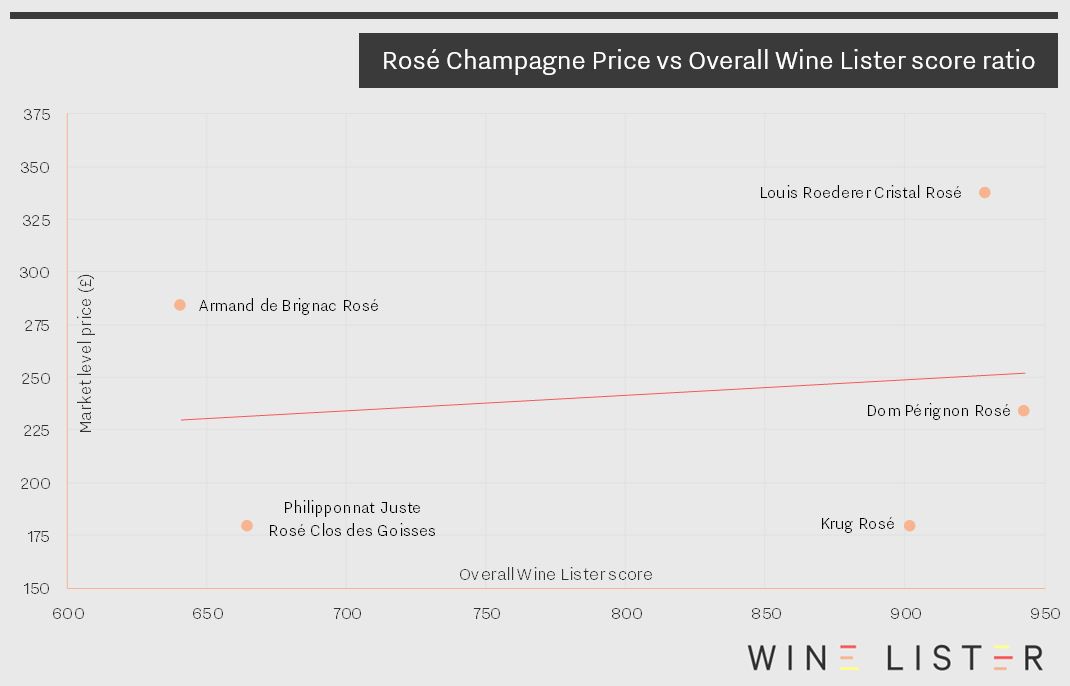
We may have been glad to see the back of January, but it certainly wasn’t all blue. The first month of the year brought excitement to the wine world with Domaine de la Romanée-Conti’s (DRC) 2015 release, and to Wine Lister with our first ever 1000-point Brand score. For much of London’s bustling City, the end of February means one thing: bonus time. The Financial Times’ February edition of How To Spend It already features the iconic DRC – below are some further ideas for wines to blow the budget.
Prices from our data partner, Wine Owners, are shown ex duty and sales tax (VAT) per bottle as averages across Wine Lister featured vintages.
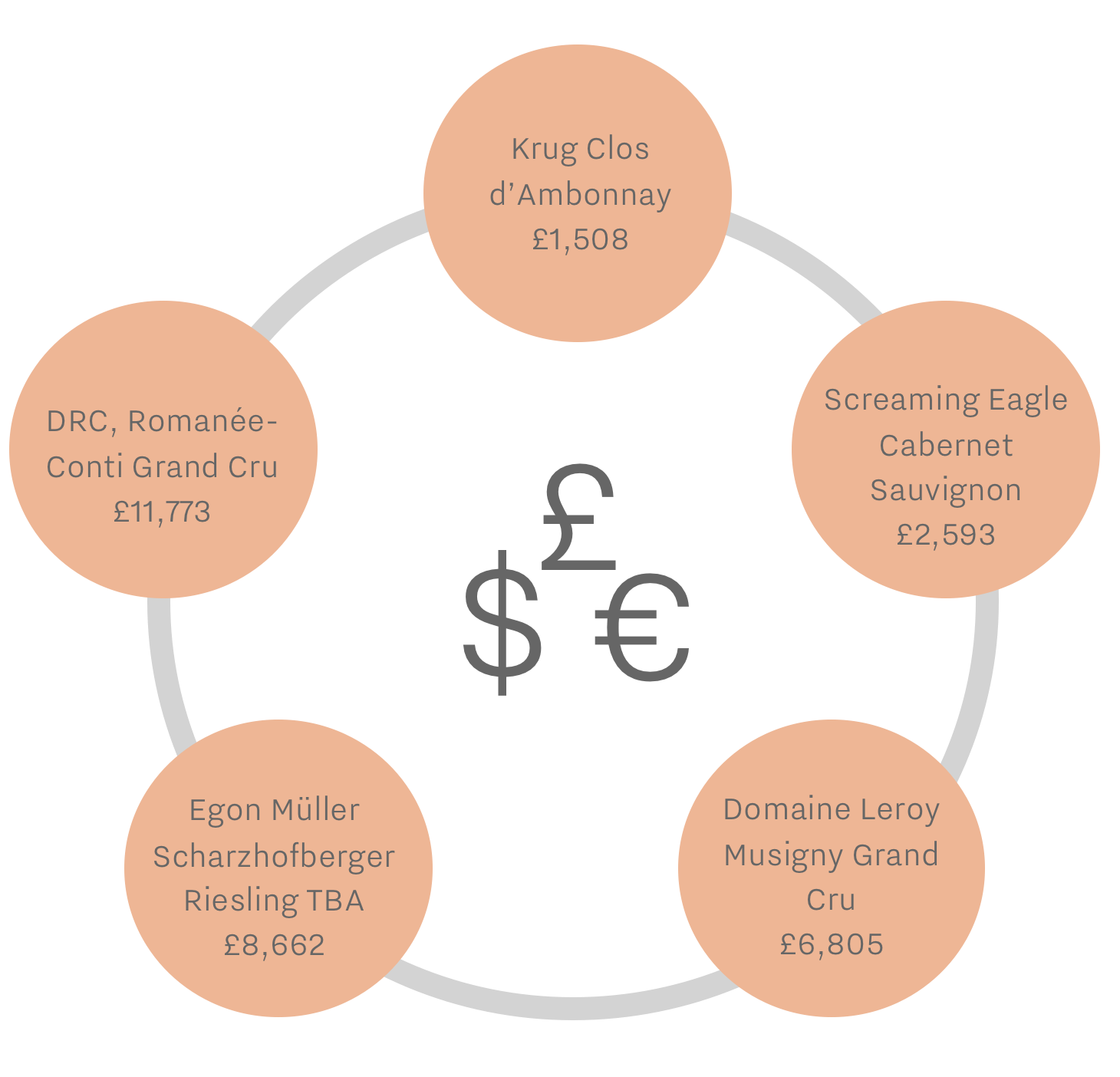
- Krug Clos d’Ambonnay
While Dom Pérignon or Louis Roederer’s Cristal are more commonly associated with City celebrations, those in the know will be toasting with Krug’s famous Pinot Noir expression. With an average Quality score of 969 and a price of £1,367 per bottle for the latest available vintage (2000), a glass of Krug Clos d’Ambonnay is, in itself, cause for celebration.
- Screaming Eagle Cabernet Sauvignon
If you’re one of the lucky few on Screaming Eagle’s direct mailing list, congratulations. It is one of the most talked-about wines by the trade based on the results of Wine Lister’s proprietary Founding Member survey, and counts over 17,000 monthly online searches on Wine-Searcher. The average £2,593 price tag per bottle is therefore a small price to pay, if indeed you are able to get your hands on one of the 7,800 bottles produced each year.
- Egon Müller Scharzhofberger Riesling TBA
Even harder to find is Egon Müller’s Scharzhofberger Riesling TBA. It breaks a number of records, including Wine Lister’s rarest wine (with an average of only 150 bottles produced per annum) and the highest ever average Wine Lister Quality score (995). Prices range from £5,848 per bottle to over £21,000 per bottle for older vintages.
- Domaine Leroy Musigny Grand Cru
The second most expensive of all French wines, let alone in Burgundy, is Domaine Leroy’s Musigny. At just over half the price of DRC Romanée-Conti, averaging £6,805 per bottle, its consistent quality is matched by impressive price growth, with a compound average growth rate of 26%. It featured in last year’s Listed blog, “the best wines money can buy”, which certainly still rings true.
Last week we were lucky enough to taste through the 2008 vintage of Bordeaux grands crus classés at BI Fine Wines’ 10 years on tasting. Below we explore what light Wine Lister scores have to shed on the quality and price performance of different appellations in 2008.
Wine Lister’s holistic and dynamic approach allows us to not only see which appellations produced the vintage’s best wines, but also demonstrates if and how the market has since reacted to each appellation’s relative quality.
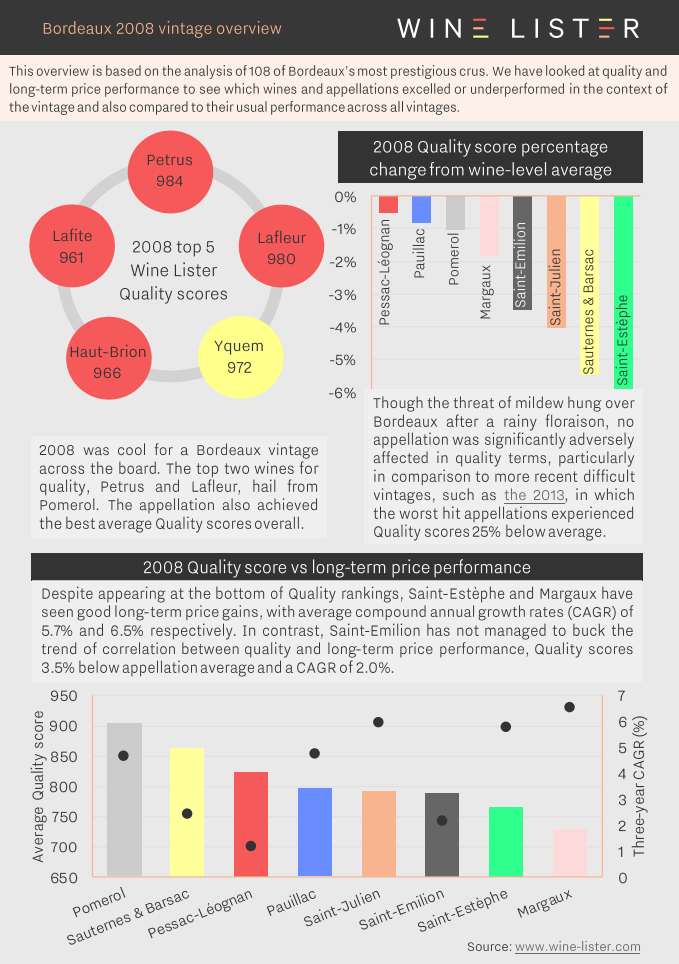
You can download the slide here: Wine Lister Bordeaux 2008 vintage overview
Featured wines: Petrus, Lafleur, Yquem, Haut-Brion, Lafite
With Burgundy having dominated our thoughts recently, we thought it was time for a change. So this week, our Listed section continues on its travels, this time stopping in the USA, to consider the country’s overall top five whites. However, whilst the landscape might be different to the Côte d’Or, the grape certainly is not. As might be expected, the USA’s top five whites are all Chardonnays – and all Californian.
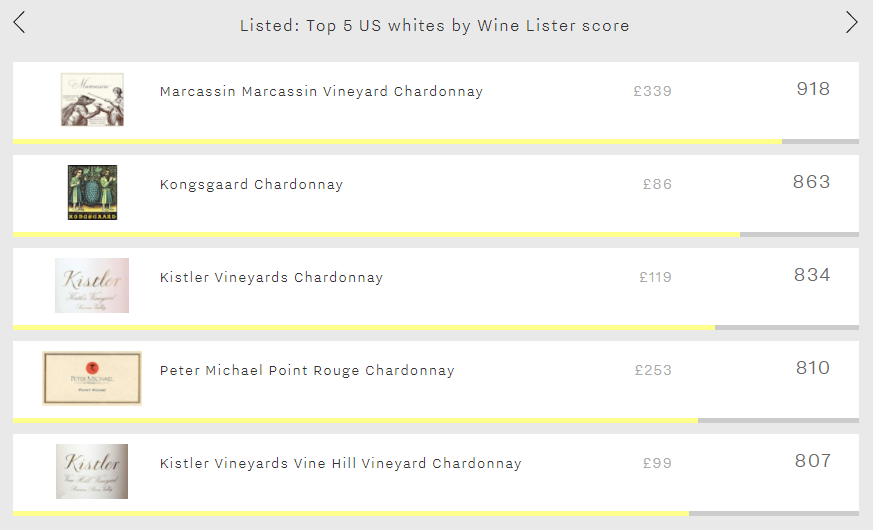
Leading the pack is Marcassin Vineyard Chardonnay, with an excellent score of 918 – putting it amongst the very best on Wine Lister. Its score – 55 points above second-placed Kongsgaard Chardonnay – is the result of excellent consistency across Wine Lister’s three categories. Whilst it comes second in terms of Quality (927), it leads in the Economics category (968), and is well out in front in the Brand category (879). The dominance of its brand is the result of achieving the group’s best restaurant presence – both horizontal and vertical – and being the most popular of the five – it receives nearly twice as many searches each month on Wine-Searcher as the second-most popular wine in the group.
Next comes Kongsgaard Chardonnay (863). The cheapest of the five (£86 per bottle), it experiences the group’s second-weakest Economics score (873). However, it starts to climb back up the table with the group’s third-best Quality score (894), and cements its position with the second-best Brand score of the five (817).
The three final wines in the group are evenly matched, with just 27 points separating Kistler’s straight Chardonnay, Peter Michael’s Point Rouge Chardonnay, and Kistler’s Vine Hill Vineyard Chardonnay. The two Kistlers display contrasting profiles. Whilst the straight Chardonnay comfortably outperforms the Vine Hill Vineyard in the Quality category (892 vs 805), the roles are reversed in the Economics category, with the Vine Hill Vineyard’s very strong three-year CAGR (16.5%) helping it to an excellent score of 951, c.70 points ahead of the straight Chardonnay. In the Brand category, despite achieving very similar scores, again they display contrasting profiles. The straight Chardonnay is over twice as popular as the Vine Hill Vineyard, but features in half the number of the world’s top restaurants.
Peter Michael Point Rouge Chardonnay – the USA’s fourth-best white – has a somewhat topsy-turvy profile. It enjoys the group’s best Quality score (933), but the worst Brand and Economics scores (641 and 827 respectively). Thanks to an extraordinary three-year CAGR of 47.7% it is also by far the most-expensive of the five, with a three-month average price of £457.
Christmas is a time of tradition. Whether we like it or not, we tend to spend each year doing, eating, and drinking the same as we did the year before. Whilst everybody’s idea of Christmas will be personal, usually based on childhood memories, there are clearly a shared set of rituals that most of tend to follow: mince pies, turkey or goose, crackers, Christmas pudding. There are also certain styles of wine that we associate with Christmas (though these associations are probably not based on childhood memories!). We decided to look a bit further into the online popularity of specific regions and styles of wine to determine whether in fact we do all drink the same things over the festive season.
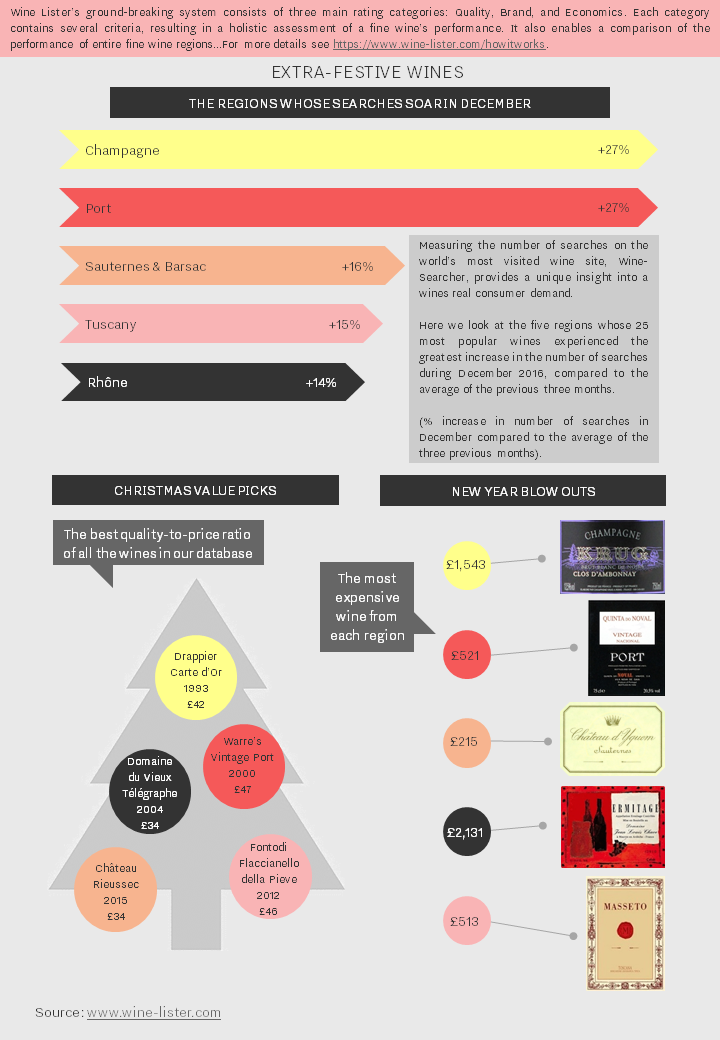
Comparing the search frequency of each region’s 25 most popular wines on Wine-Searcher during December 2016 compared to the average of the previous three months, the results are conclusive. Champagne and Port both enjoyed a dramatic surge in popularity – receiving over a quarter more searches during December. Whilst Port’s dramatic increase in online search frequency was presumably because it is the classic accompaniment to another festive favourite – Stilton – Champagne’s seasonal rise in popularity must be because it is not just the tipple of choice at Christmas parties, but also at New Year’s celebrations.
It seems that we also tend to favour the sweet whites of Sauternes and Barsac over Christmas, their 25 most popular wines enjoying a 16% increase in online search frequency. When it comes to dry reds, we appear to gravitate towards hearty styles at this time of year, with Tuscany and the Rhône also experiencing noticeable boosts in online popularity (up 15% and 14% respectively).
If you haven’t yet stocked up on those perennial favourites, Wine Lister’s Value Pick search tool can help you effortlessly find top Quality at a reasonable price. Each of our Christmas Value Picks achieves an outstanding Quality score of at least 965, putting them amongst the very best on Wine Lister. With the most expensive – Warre’s Vintage Port 2000 – available for as little as £47, they represent remarkable value.
If you are after a really special bottle for New Year’s, then we also show the most expensive wine from each region. Each of these wines qualify as Wine Lister Buzz Brands, and is sure to help start 2018 with a bang.
Download a PDF version here.
First published in French in En Magnum.
Wines featured: Drappier Carte d’Or 1993; Domaine du Vieux Télégraphe Châteauneuf-du-Pape 2004; Rieussec 2015; Fontodi Flaccianello della Pieve 2012; Krug Clos d’Ambonnay; Quinta do Noval Porto Nacional Vintage Port; Château d’Yquem; Jean-Louis Chave Hermitage Cuvée Cathelin; Masseto
This week’s top five takes Wine Lister to the Douro Valley in search of its vintage ports. In some ways this top five is very much a four plus one, with the fifth placed Quinta do Noval Nacional, costing nine to ten times more than each of the others. It is also the only one to enjoy Buzz Brand status. At a total Wine Lister score of 880 and £521 per bottle, against the top-ranked Taylor’s 932 and £60, that constitutes quite a buzz.
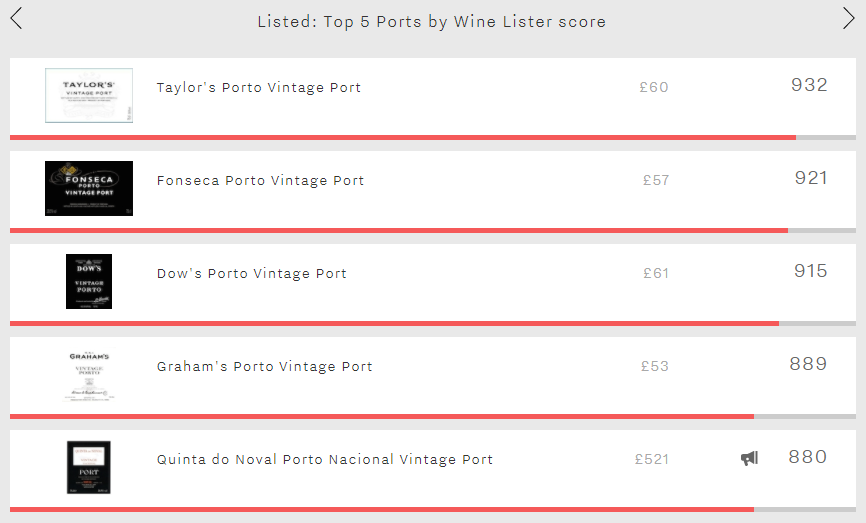
Here is a classic case of all metrics count but some count for more than others when it comes to cost. With a stonking 981 for Quality and the longest drinking window in its peer group the Quinto do Noval is clearly the nichest of the niche; its relatively low restaurant presence (9%) and monthly searches (2,457, on average, to Taylor’s 10,787) make its Wine Lister Brand score (825) well below Taylor’s and the other three.
With an overall score of 932, an excellent Quality score of 967, and a Brand score of 965 based on decent restaurant presence (23%) and over 10,700 average monthly searches, Taylor’s tops the Vintage ports. Fonseca comes a close second at an overall 921. With almost identical Quality (965) and slightly lower Brand (942), Fonseca just pips Taylor’s for liquidity, with 1,072 (against 1,061) of its top five vintages traded at auction in the past year.
At around £60 per bottle on average, Taylor’s and Fonseca are each affordable flutters with future Christmases in mind. Even illustrious older vintages such as 1970 and 1977 – in their drinking prime this Christmas – can be found at two to three times the price.
The same goes for third-placed Dow’s (£61) and fourth-placed Graham’s (£53). At an overall 915 Dow’s has a slightly lower Quality score than the top two. 943 is nevertheless still highly creditable. Graham’s edges Dow’s on Quality at 948 but a relatively lowly 650 for Economics brings it down to 889 overall.
All in all, Taylor’s and Fonseca merit their top two spots. If Santa has very deep pockets then consider adding Quinto do Noval 1994 to your wishlist (at a cool £1,229).
As we edge ever closer to Christmas, it feels appropriate to take a look at sweet wines. Here we consider Alsace’s top 5 sweet whites by overall Wine Lister score. Produced in a thin sliver of land in the far East of France, Alsace’s top sweet whites are separated by just nine points (less than one hundredth of Wine Lister’s 1,000-point scale!). The five wines display very similar profiles, all outperforming in the Quality category, achieiving middling Brand scores, and trailing economically.
Four break the 900-point boundary in terms of Quality scores, putting them amongst the very top quality wines on Wine Lister. Hugel et Fils Riesling Vendange Tardive (VT) falls just short with 881 points, still a very strong Quality score (thanks to 17/20 from both Jancis Robinson and Bettane+Desseauve, and 92.5/100 from Vinous). The same producer’s Gewürtzraminer VT scores even higher for quality (910) thanks to a 95/100 from Jeannie Cho Lee:
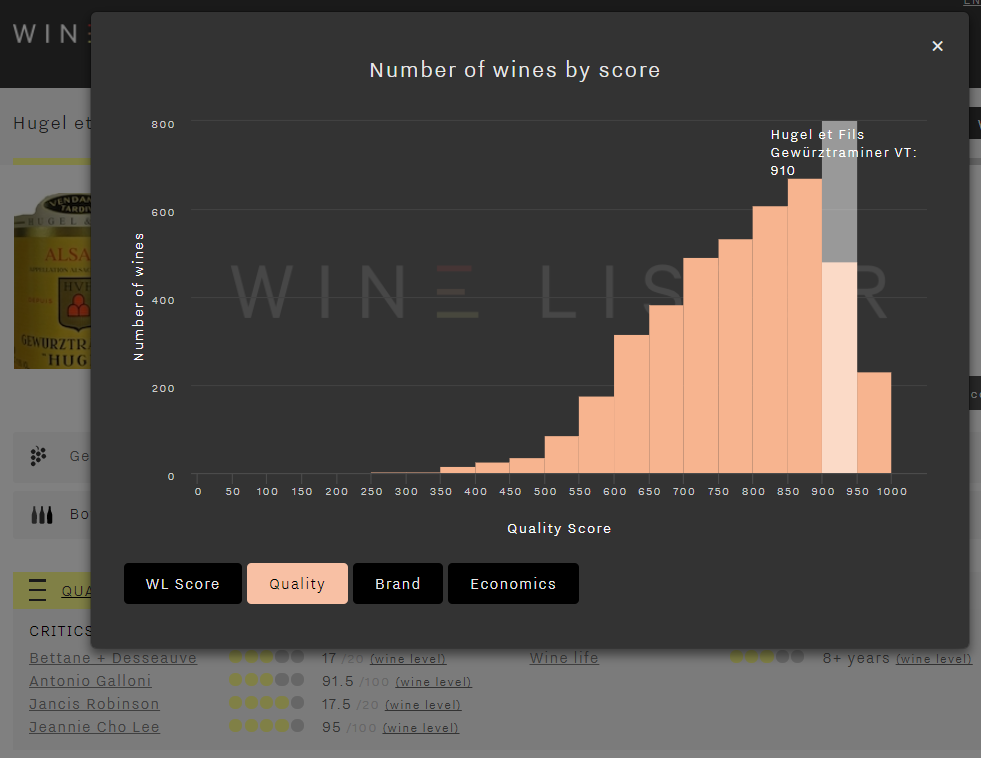
Moving categories, scores drop sharply from an average Quality score of 915 to 550 for Brand – still above the average for all wines on Wine Lister:
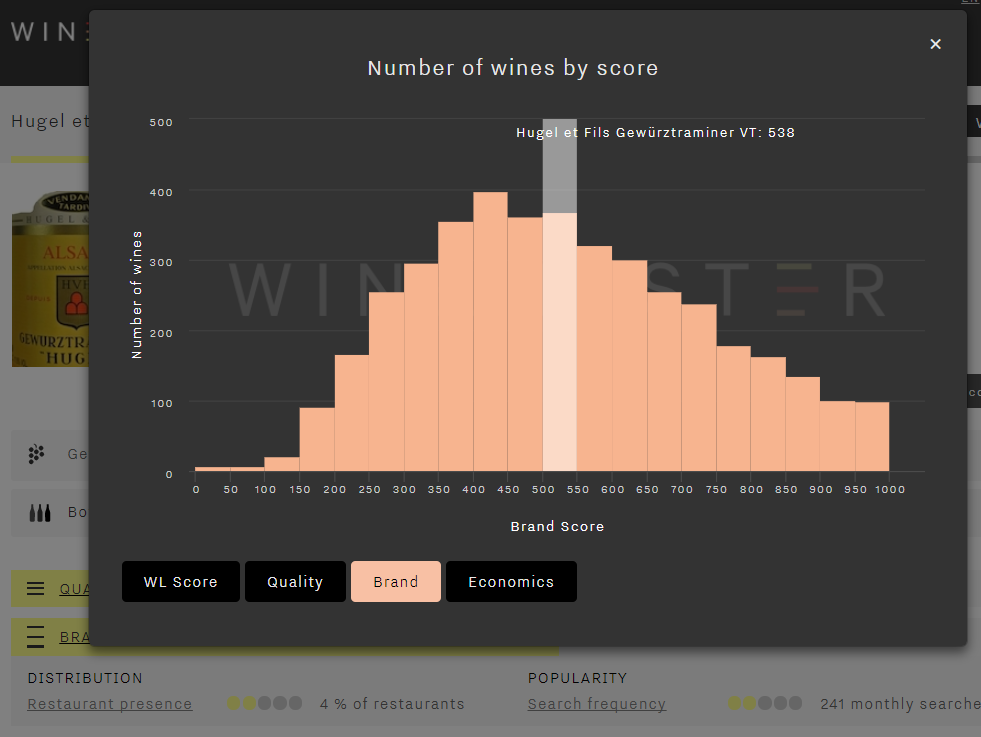
Economics scores trail even further behind, averaging 338, hindered by low liquidity. For example, Hugel’s Gewürtzraminer VT failed to trade a single bottle at auction over the past four quarters (as measured by Wine Market Journal). The chart below shows Economics score in the context of all the wines on Wine Lister – its is well below the average, with a score below 400 putting in the “weak” score band:
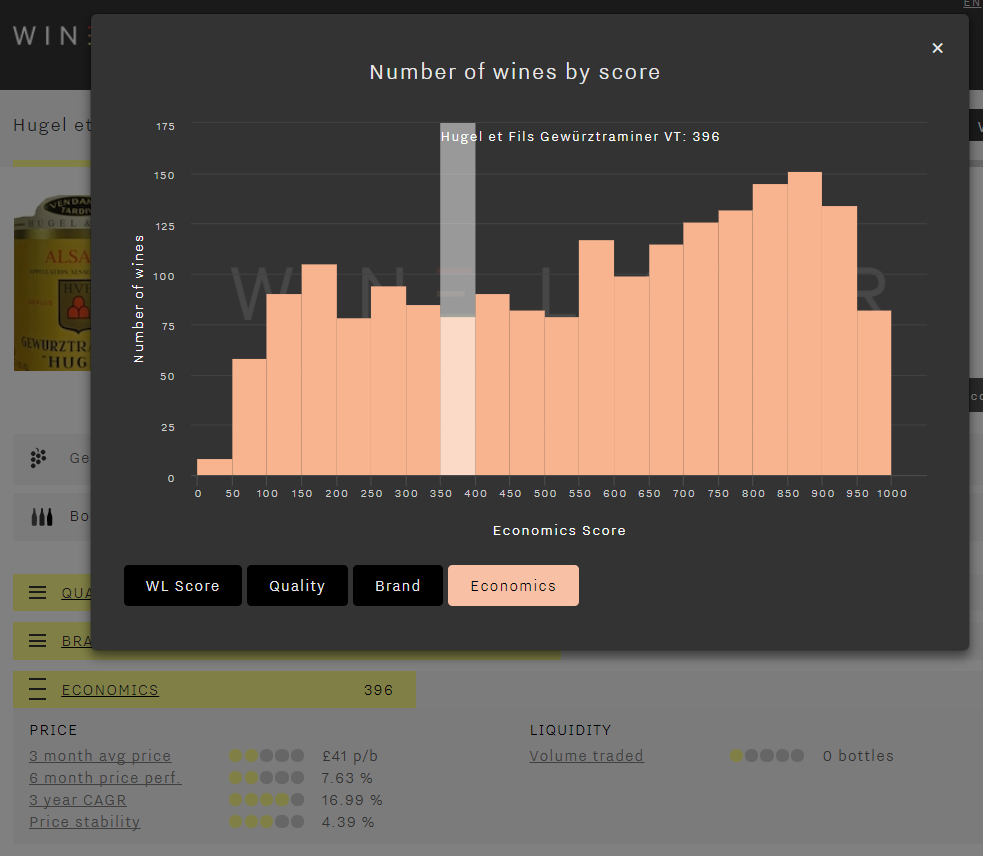
Other wines making the top five are Zind-Humbrecht Jebsal Pinot Gris VT (675) and Trimbach Gewürztraminer VT, which achieves the best restaurant presence of the group. However, featuring on just 6% of the world’s best restaurant lists, this suggests that Alsace’s sweet whites are not every sommelier’s must-list bracket, even when produced by the region’s most famous producer. Incidentally, Trimbach’s Clos Sainte Hune appears in 34% of wine lists (compared to 69% for Sauternes’ Château d’Yquem).
The last wine making it into this week’s Listed section is Marcel Deiss Altenberg de Bergheim Grand Cru. The only non-single varietal wine of the group, it is a blend of 13 different varietals planted in the same plot, and is by far Bettane+Desseauve’s preferred wine of the group – the French duo award it an average score of 19/20. It is also the most popular wine of the group. However, its modest average search frequency (380 per month on Wine-Searcher) confirms that Alsace’s sweet whites currently fly well under the radar.
So, when you’re stocking up your cellar for Christmas, give Alsace’s sweet whites a go. They might not be the most prestigious, but the quality is there and prices are pleasing.
We are thrilled to announce the addition of Jeannie Cho Lee MW as Wine Lister’s fourth partner critic, representing the Asian market.
Wine Lister gathers data from multiple sources to assess thousands of wines on a truly holistic basis. Scores are made up of three main categories: Quality, Brand, and Economics. Critic ratings form a vital part of the Quality category, providing reliable scores and drinking window information.
Jeannie Cho Lee is an independent wine critic, a university professor, and an award-winning author who in 2008 was the first Asian to become a Master of Wine. Based in Hong Kong, she writes about wine on her website, www.jeanniecholee.com, and has also published several books, including Asian Palate.
Adding to our unique collaborations with three of the most reputable wine critics in the world’s major fine wine markets – Jancis Robinson (UK), Antonio Galloni (Vinous) (USA), and Bettane+Desseauve (France) – we are delighted to welcome Jeannie Cho Lee to represent the key Asian fine wine market. This careful addition will help us in our goal of providing ever more reliable and accurate ratings and analysis, while crucially maintaining the high standards of this elite pool of critics. Jeannie Cho Lee’s scores have been added to those of our existing partner critics, and fed into Wine Lister’s bespoke algorithm to produce a Quality score out of 1,000 points. Wine Lister takes each critic’s minimum and maximum wine ratings and spreads these back out over the entire scale. As each wine critic scores differently (not just on a different scale), we also account for the frequency of ratings and normalise scores for fair comparison. Each critic is weighted equally.
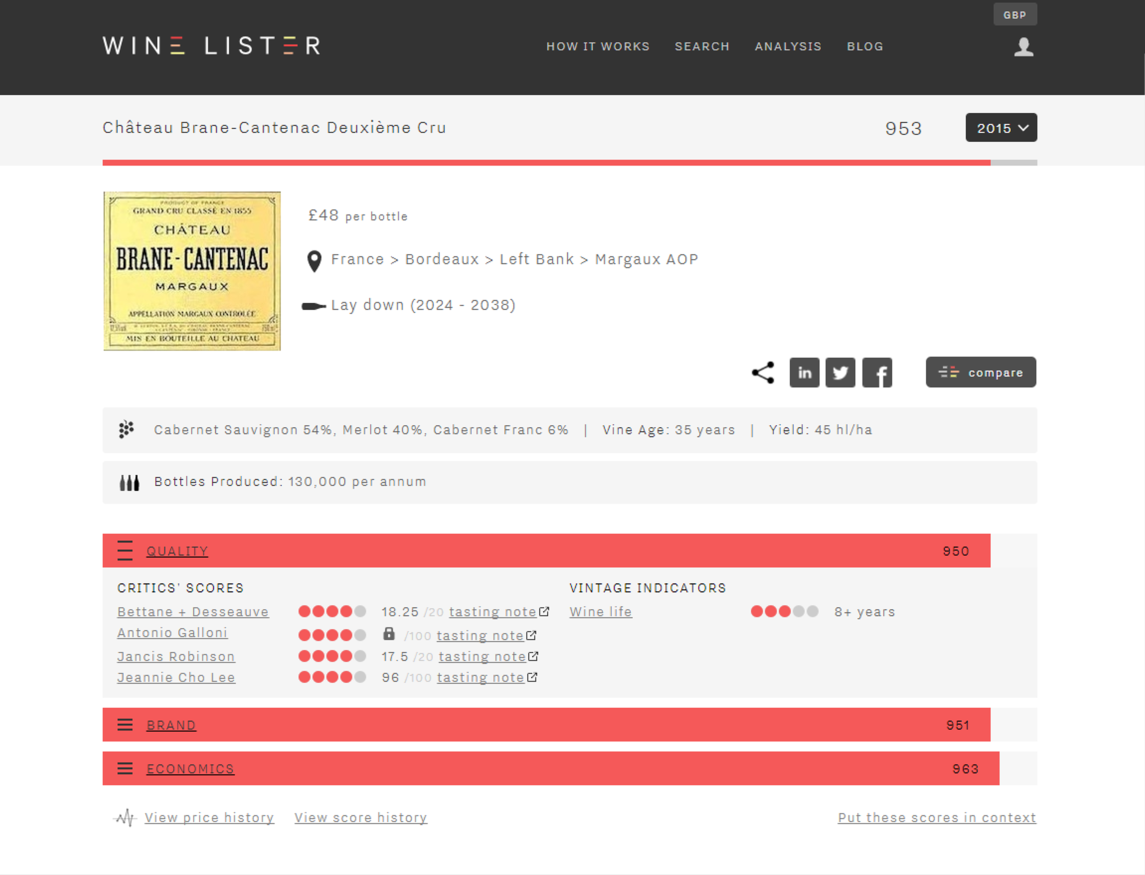
You may notice that some scores have changed for wines that have not been rated by Jeannie. In order to meet our goal of having the most comprehensive and up-to-date information, and the most rigorous rating algorithm, we have increased the sample set of scores upon which we carry out the normalisation between critics. This now includes the 18 months’ worth of new critic scores since our launch.
One of Wine Lister’s four Indicators, Value Picks identify the wines and vintages which have the best quality to price ratio, with a proprietary weighting giving more importance to quality, thus giving the finest wines a look-in.
With the latest price data in, 28 new wines have recently qualified as Value Picks. While Value Picks are calculated using a three-month average bottle score for accuracy (in order to take into account any price fluctuations), we have shown the current price per bottle below for ease of comparison. Please note that the price shown is excluding duty and VAT, and often reflects prices available only when purchasing a full case:
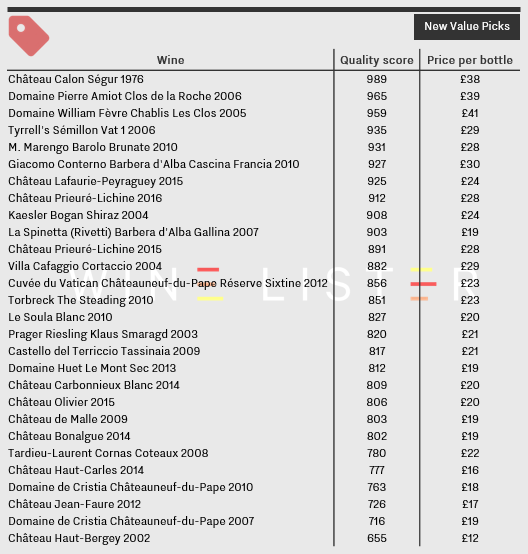
Bordeaux dominates the new Value Picks, filling 11 of the 28 spots. Margaux’s Prieuré-Lichine seems a particularly keenly-priced brand at the moment, with both its 2015 and 2016 vintages now Value Picks. With Wine Lister Quality scores of 891 and 912 respectively – very strong and amongst the strongest on Wine Lister’s 1000 point scale – and both priced under £30, they represent excellent value buys. Within Bordeaux, Pessac-Léognan is home to the highest number of new Value Picks. Of those, two are white, with Château Carbonnieux Blanc 2014 and Château Olivier 2015 achieving very similar Quality scores (809 and 806 respectively), and each priced at just £20.
The other wine to feature twice in the latest update is Domaine de Cristia Châteauneuf-du-Pape, with its 2010 and 2007 vintages. The former, which achieves a Quality score of 763, is available at just £18 per bottle. With plenty of life left in it, it looks like a great buy.
Three Piedmontese wines recently qualified as Value Picks – M. Marengo Barolo Brunate 2010, Giacomo Conterno Barbera d’Alba Cascina Francia 2010, and La Spinetta (Rivetti) Barbera d’Alba Gallina 2007. All three achieve powerful Wine Lister Quality scores of over 900 points. You might buy Giacomo Conterno’s wines to impress – the Barolo Cascina Francia is a Wine Lister Buzz Brand, but also averages £157 per bottle. If you’re looking for something more appropriate for a weeknight, the 2010 vintage of the same producer’s Barbera d’Alba, priced at just £30, would be an excellent Value Pick – a perfect example of how Wine Lister’s indicators can help you find the right wine for any situation.












